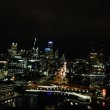By Ahmed Wafi
During the the three-month semester vacation, I opted not to take the short semester, instead I thought it would be a good idea to earn some extra cash as I’ve come to the realisation that I am now in the midst of adulthood.
Apart from the part-time job that I took up, I was also blessed with the opportunity to travel to Melbourne, Australia where my aunt lives with her husband. Obviously many locals know Australia as being a hub for higher education with world renowned universities situated there including Monash University, The University of New South Wales and Curtin University to name a few. Two of the three universities mentioned have set up campuses in Malaysia.
While in Melbourne, I paid close attention to the Australian culture and could not help but compare it with the culture I am accustomed to in Kuala Lumpur. The environment was just something else. The public transport seemed to be so much more efficient and reliable. There was a wider variety of food and drinks located in the supermarkets, the drivers were much more courteous and law abiding. Everyone just seemed happier. Obviously, I’m not the first Malaysian to make such comparison and I definitely won’t be the last.
During my stay, my aunt and her husband were kind enough to give us a tour of the many places across Melbourne including the breathtaking view found in the Great Ocean Road and the cuddly kangaroos and koalas in the Maru Koala and Animal Park. One thing that caught my eyes during the journey from Clayton to Great Ocean road was that as soon as you leave the city, the only thing you will see are farms, cows and sheep. It was nice to look at since I”m not accustomed to seeing cattle by the side of the highway and I’m sure locals would eventually get bored of seeing animals eating grass. I hold a high level of admiration towards Australia’s laws that protect their wildlife and I would say that Australia lives side by side with their unique wildlife animals most notably the kangaroos and koalas. In fact, while cruising through the roads in the countryside it’s very much normal to see koalas hanging on branches feasting on eucalyptus or seeing wombats frolicking through the thick grass.
The sports culture in Australia really caught my eyes. I once heard a man on television saying ‘In Australia, you don’t ask a person do you play sports?’ rather you ask them ‘what sports do you play?’. For the life of me I can’t remember who said that because it was quite a few years back and for some reasons that statement just got stuck in my head up to this date. From my experiences, what the man said seemed to be spot on. Everybody seems to take part in some sorts of sports.
While walking past a bridge overlooking the Yarra river, you could look down and see people happily rowing through the river. While in the passenger seat of the car looking out of the window you could see at least a dozen cyclists every ten minutes or so and who should be held responsible for an active and fit society? Two groups. Firstly, the individual athlete himself and also the Australian government for making sports accessible to all. Bicycles are affordable to all, fields are aplenty in fact one university I walked through had four large fields that were kept in tip top condition.
Gymnasiums could be found every two to three kilometers and quite a large number of these gymnasiums would operate around the clock, 24/7, 365 and the government had prepared bicycling lanes throughout the city. After you’re done with your daily exercise you could drop by the local convenience store or petrol station and treat yourself to a wide variety of  health drinks that are packed with protein and for a affordable price too (as long as you don’t convert the Australian dollar to the Malaysian ringgit).
A lot of facilities whether it be sports facilities, shopping outlets or restaurants in Australia, Japan, England and even Singapore are usually within walking distance of a neighbourhood. If it’s not within walking distance you could usually catch a bus or walk to the train station (which is almost always within walking distance) and this motivates people to be more active! Unlike in Kuala Lumpur, unfortunately, where many of us choose to drive from point A to point B even when point B is not more than a five minute walk but you can’t put all the blame on the individual. Kuala Lumpur has been designed in such a way where facilities are not as compact compared to the countries mentioned above and for some reasons, we are not advancing our public transport system. The current public transport system is quite costly, specifically referring to taxi cabs.
In the past few years, you could see a change in the mindset of people around Kuala Lumpur. More people are becoming active in sports, bicycles on the highway are more common than they used to be about ten years ago, the parks are being filled with more joggers and with the hashtag #FitMalaysia launched fairly recently, we’re on our way to be where we want to be. I just hope that the people responsible for sports in Malaysia want to be at the top of the world. Easier said than done but with the year 2020 coming up, Malaysia can do so much better than being on the losing end of a 10-0 scoreline.
As of right now, the grass is greener on the other side. How long will it stay that way?***




